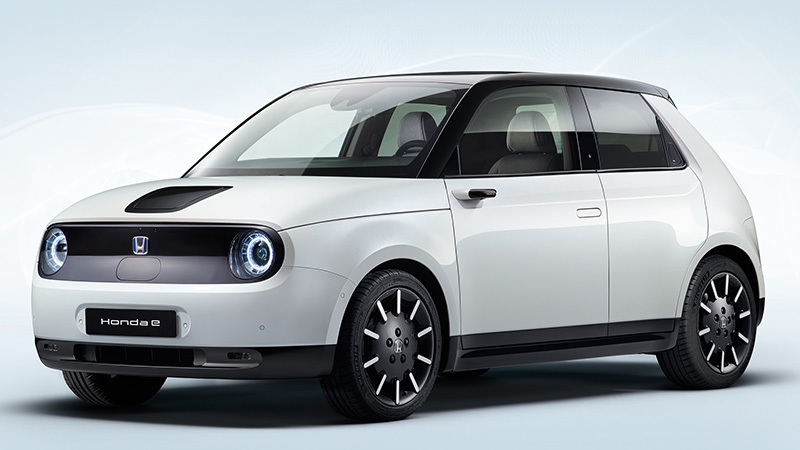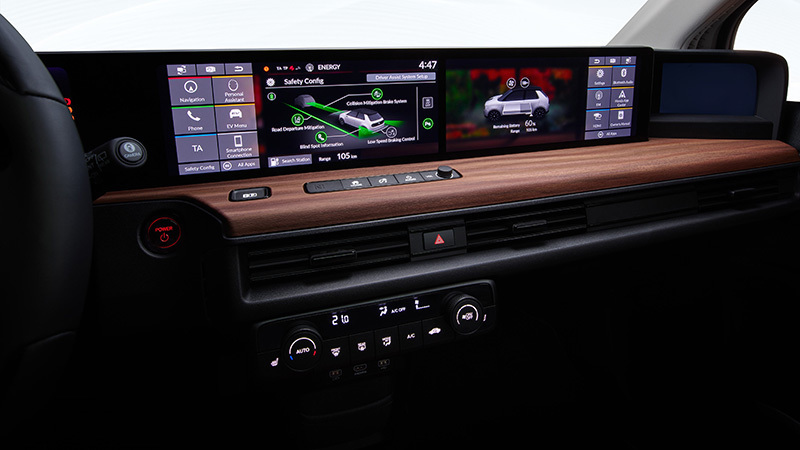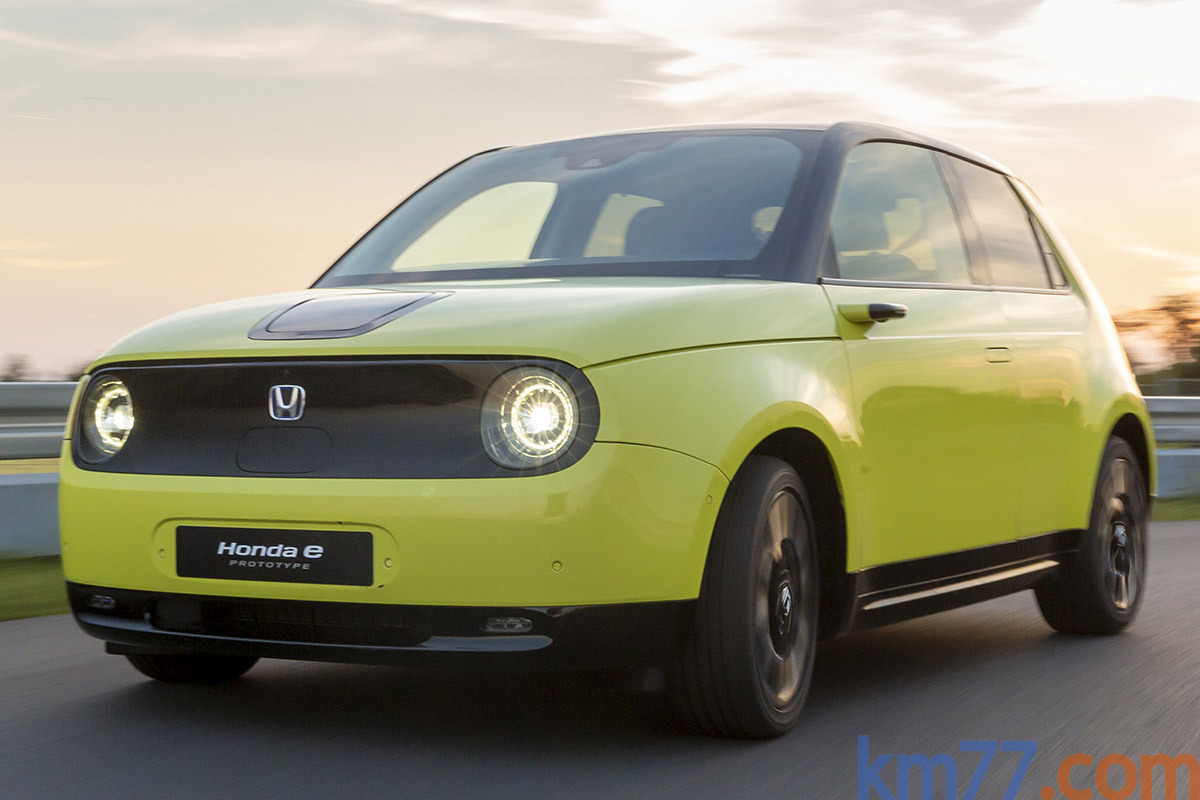HONDA
Honda e prototype review
We drive a prototype version of the Honda e ahead of its full launch later this year
BMW proved that premium doesn’t have to come in a big package when it launched the reborn Mini. And look at how well that’s done.
Now Honda has a point to prove, too, with this; the
pure electric Honda e. If we gloss over the apologetic, unimaginative ‘e’ name, the squat stance and owl-eyed expression is the absolute business. And it needs to be, because Honda is pitching its retro-chic city car upmarket.
It’s expected to cost from well over £30,000 when it goes on sale at the end of this year, which is rather a lot given that it’s smaller than a Honda Jazz, and gets a WLTP range of 125 miles from its 35.5kWh battery.
Sit inside it, though, and it’s clear how the price might be justified. Slide into the driver’s seat, which has dense, textile covering, and you’re faced with a touchscreen horizon stretching the width of the car. Screens for the side cameras (in place of wing mirrors) bookend the three central screens, and even the rear-view mirror doubles as a rear-facing camera should you want it.
This cliff face of screens – the central two central screens being touchscreens - is standard in the little Honda, and chief among its selling points. It’s a bit overwhelming at first, but the good news is that the menus seem fairly logical and the screens responsive, and you can also dim the screens or turn them off altogether for night driving.
You can of course programme charging via the screens, although Honda is launching the e with a smartphone app that will allow you to do this remotely. It’ll let pre-set the interior temperature, too.
That charging happens via the gloss black panel on the bonnet of the car, which pops open to reveal a socket for
CCS and Type 2 cables. These are the standard plug types in the UK and Europe, and give you access to most of the existing public charging points, and all new ones being installed.
Plug the Honda e into a 50kW charger - common on UK motorway service stations - and you’ll get an 80% charge in around 40 minutes. It can also take advantage of new, 100kW chargers being rolled out across the UK, which will deliver the same charge in 30 minutes.
A 7kW home wallbox charger will deliver a full top-up in less than six hours, or a normal three-pin plug will do the job in around 15 hours.
It’s great to drive, too, going on the evidence of our time in a prototype car. Being short and wide, with short overhangs and a rear-wheel drive setup, the Honda e swings into corners with proper relish.
The steering is fairly slow but it has a lovely smooth, natural progression to it that makes you feel immediately confident in where it’s pointed, and will make it a pleasure to drive on faster roads or around town.
One of its best tricks is a turning circle of under nine metres, which is right up there with the
Smart EQ ForFour and makes it feel like it’s turning on its own length. Perfect for awkward multi-storeys and cheeky u-turns.
The body feels neatly tied down, too – there’s not too much lean at all - although we’ll refrain from commenting on ride comfort until we’ve driven it somewhere other than the smooth-surfaced compound where our prototype cars were given free reign.
It’s not terribly fast, mind you. It lacks the instant, almost shocking surge of acceleration that others – notably its main rival, the
BMW i3 – can offer. But it does fire off the line with enough urgency to satisfy, and there’s enough mid-range response to give you confidence for merging into faster traffic, too.
One niggle is that there are almost too many brake regeneration modes. In the default drive setting, you have four levels to toggle through via the steering-wheel mounted paddles, which gradually increase or reduce the brake regen’.
This automatically kicks in as you lift off the accelerator, topping up the battery, but even in its maximum standard setting, the Honda e coasts quite fairly freely.
However, hit the ‘single-pedal’ button and much stronger brake regen’ kicks in. As with the
Nissan Leaf’s ‘E-Pedal’, the idea here is that you can navigate slow traffic by using just the accelerator pedal. In the Honda e there are a further three levels of aggression to choose from in single-pedal mode.
That said, the Honda’s brake regen bleeds in smoothly even in the most aggressive mode, so you easily get a feel for the pedal response and how quickly the car will stop: it’s certainly more intuitive than the Leaf.
Even so, seven levels of brake recuperation seems like overkill, and that’s before you factor in the radar-control system that automatically adjusts the brake regen’ to help you keep your distance from the car in front.
It won’t take long for you to find a setting you like, and having the one-pedal mode for around town and the less intrusive modes for faster roads does make sense.
Practicality is perfectly good in the Honda e. In fact, for a car that’s shorter than a Ford Fiesta, it has impressive rear headroom and legroom, so you can easily sit an adult comfortably behind a long-legged driver.
The boot’s a bit pokey, and has a high lip with no underfloor storage since the electric motor is hidden underneath it. But it will likely be all that most inner-city dwellers need.
All of which is great news for the admirably characterful Honda e. After all, how could anybody not want this wide-eyed little city car to succeed? It’s a refreshing break from blander alternatives, which include everything from the much longer-range and cheaper
Renault ZOE, to the familiar and brilliant i3.
But is that range of 125 miles going to be a deal breaker? Well, possibly yes. While very, very few people living in a city need even close to that amount of range on a daily basis, many of them who bother to buy cars at all do so because they want to escape at the weekend. And that means some longer motorway miles, which could be where the appeal of the Honda comes undone.
And the price? We’ll have to wait for confirmed figures and specs, as well as for a proper drive on public roads, before passing final judgement. But actually the Honda e does feels boutique enough to justify its price. Stuffed with tech and the sort of design genius that makes you want to put a Warhol-style poster of it on your wall, it’s not short of appeal.
Here’s hoping that UK electric car buyers will be open-minded enough, or perhaps realistic enough, about their mileage needs to see past what seems a limiting range next to its rivals.
Honda e specs
Price £32,000 (est)
Battery 35.5kWh
Layout Single-motor, RWD
0-62mph 7.8 seconds (est)
Top speed 85mph (est)
Range (WLTP) 125 miles
BiK band 16%
Company car tax 20%/40% TBC
Fastest charge (20%-80%) 100kW / 20 mins
7kW charge (100%) 6 hours
https://www.drivingelectric.com/honda/e
































